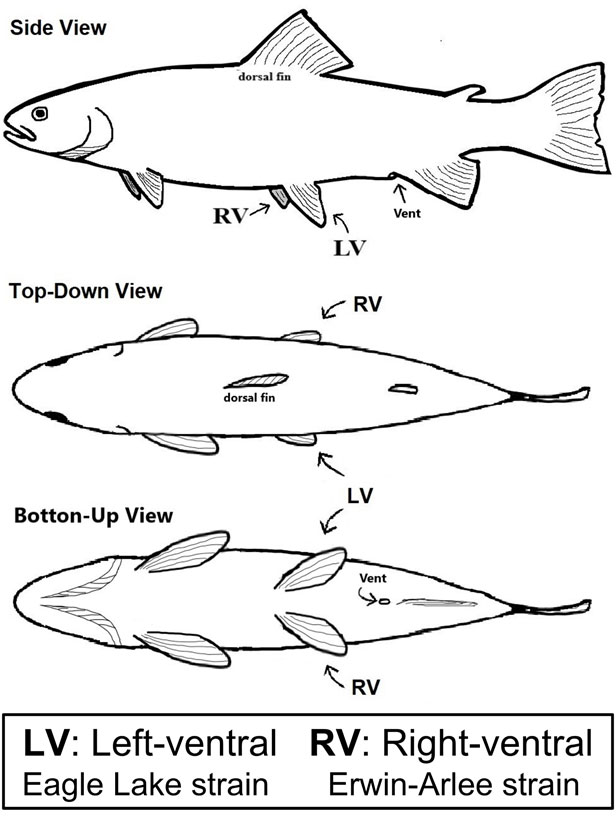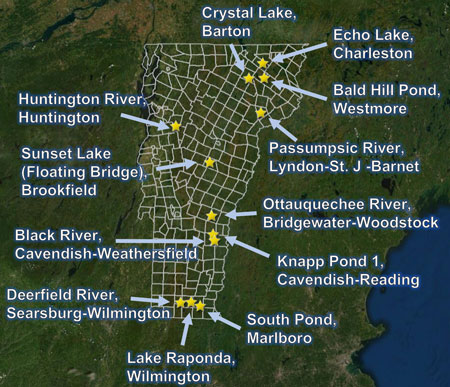We are testing a different genetic strain for a better fishing experience!
Help us provide the highest-quality recreational fishery for all anglers!
Between the spring of 2022 and fall of 2024, the Fisheries Division will be stocking a new genetic strain of rainbow trout in 12 waterbodies alongside our traditional strain to evaluate differences in performance.
Help us determine which strain to stock in the future
If you catch a stocked rainbow trout during this time from one of the waterbodies listed below, check for a missing or “clipped” ventral fin located about halfway along the underside of the fish near the opening or “vent.” Either the right or left fin will be clipped, telling you which strain you caught.
Remember to take a photo!
Submit your photo showing the clipped fin and report your catch on our online reporting tool. You can also report your catch on your smartphone using our Vermont Outdoors app, available for both Apple and Android devices.
Your submission will help us better understand how each strain performs and will directly influence our management of stocked rainbow trout in Vermont.
When is this evaluation happening?
This evaluation has already begun! Our fish culture staff has been raising our new Eagle Lake strain since January, 2021 and will begin stocking the spring of 2022. We will continue to stock and evaluate the Eagle Lake strain each year through 2024. A final decision about which strain we will continue to stock will be made by 2025.
Where will the new strain be stocked?
The Eagle Lake strain will be stocked in 12 waters alongside our current Erwin-Arlee strain. By stocking both strains in the same waters, biologists will be able to directly compare the performance of each strain and determine whether a change in our rainbow trout strain will improve angler experience.
| Waterbody | Town |
|---|---|
| Black River | Cavendish and Weathersfield |
| Deerfield River | Searsburg and Somerset |
| Ottauquechee River | Bridgewater and Woodstock |
| Huntington River | Huntington |
| Passumpsic River | Lyndon, St. Johnsbury and Barnet |
| Lake Raponda | Wilmington |
| South Pond | Marlboro |
| Knapp Pond 1 | Cavendish and Reading |
| Sunset Lake | Brookfield |
| Crystal Lake | Barton |
| Bald Hill Pond | Westmore |
| Echo Lake | Charleston |
How do I tell the two strains apart?
 Our staff is assessing differences between the currently stocked Erwin-Arlee strain and the Eagle Lake strain of rainbow trout. This strain is new to Vermont waters but has shown promise by use in other states such as Maine, Michigan, Montana, and many others!
Our staff is assessing differences between the currently stocked Erwin-Arlee strain and the Eagle Lake strain of rainbow trout. This strain is new to Vermont waters but has shown promise by use in other states such as Maine, Michigan, Montana, and many others!
The strains will look very similar which makes telling them apart challenging. To identify each strain, one of their ventral fins will be clipped. Look for the paired fins on the underside of the fish about halfway along its body. Either the right or the left ventral fin will be missing, indicating which strain you have caught. If the left fin is missing, you’ve caught an Eagle Lake strain. If the right fin is missing, you’ve caught an Erwin-Arlee strain.
What characteristics we are looking for in a new rainbow trout strain?
While all rainbow trout are the same species, there are many strains with different genetic traits that can impact their performance in our fish culture stations and in the wild. Biologists periodically compare different strains of trout for characteristics that may be more desirable and help enhance opportunities for all anglers to catch stocked trout.
-
Hatchery survival: Fish culture is a science, and it takes a lot of skill and expertise to raise fish in tanks, ponds, and raceways that can survive long enough to be put into Vermont waters. We want to ensure Vermont’s five hatcheries can successfully raise the Eagle Lake strain and grow it to a size that can be stocked.
-
Catchability: We want anglers to catch stocked trout. This evaluation will allow us to determine if the Eagle Lake strain can be caught just as easily as the Erwin-Arlee strain we currently stock.
-
Survival after stocking: While the rivers we stock are typically too warm for trout to survive through the summer, many lakes and ponds are cold and deep enough for trout to survive. The current Erwin-Arlee strain does not survive or “hold-over” well. We will soon be able to determine if the Eagle Lake strain survives better than our current strain.
-
Growth: Everyone wants to catch a big trout! If the new Eagle Lake strain can survive in lakes and ponds for multiple years, we will be able to look at growth and age to see how big this strain may get in Vermont waters.
Your input matters!
Data collected during this evaluation will provide important information we will use to ensure that our fish culture program can efficiently raise these fish, that they perform well in the wild after being stocked, and that they provide a high-quality recreational fishery.

